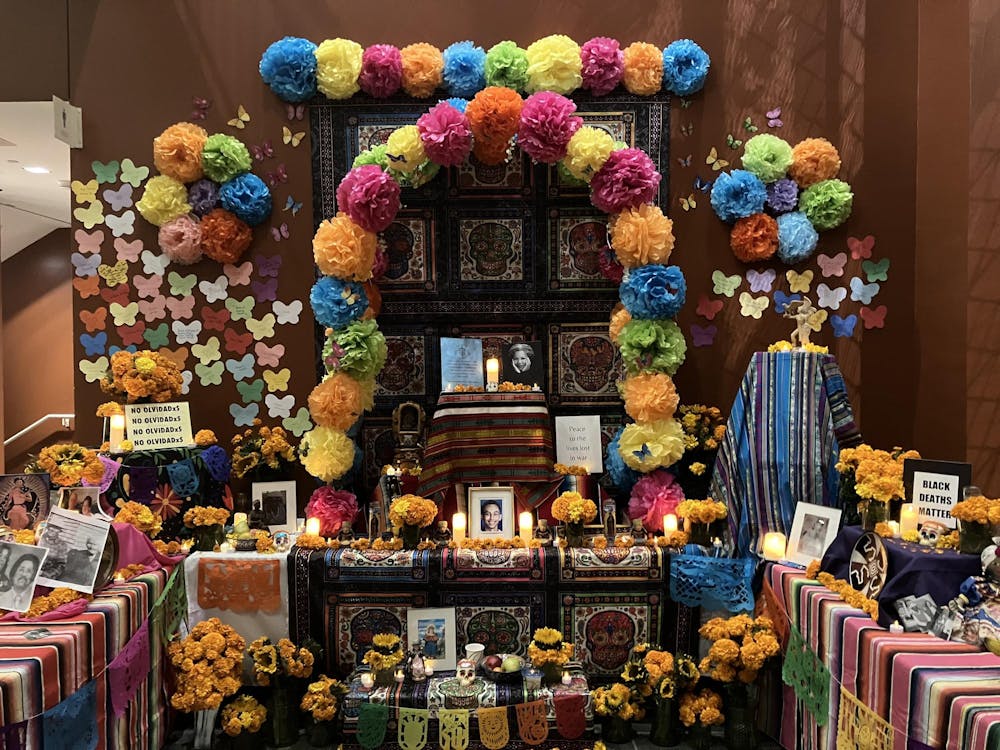Complete with an ofrenda, dancing, poetry, songs, and prayers to honor the dead, Día de los Muertos at Princeton is a celebration full of community, respect, and love.
The lobby of East Pyne in the afternoon of Oct. 29 was already alive with ritual chanting and music, packed with people who had come to honor the life of their deceased loved ones. People who had celebrated Día de los Muertos all their lives and those celebrating it for the first time formed an arc around the altar as individuals brought forward food, flowers, photographs of those honored who have passed on, and other offerings to add to the ofrenda.
The ofrenda is a central component of Día de los Muertos, or Day of the Dead, a Mexican holiday traditionally celebrated on Nov. 1 and 2 to honor deceased loved ones and celebrate the cycle of life and death. On these days, it is believed that the souls of the deceased cross back over into the land of the living to spend time with their families, who place their photographs, favorite foods and objects, candles, marigold flowers, and other special items on the ofrenda in preparation for their arrival.
The ofrenda in East Pyne is made up of tables covered in colorful cloth, orange marigolds, bright tissue paper flowers, papel picado, and the beautiful butterflies and skull tapestry on the wall, acknowledging the vibrancy of life and lives lived. Yet, the photographs and candles ensure that even a casual passerby knows that this is a space of remembrance.
For those who did not have offerings but still wished to honor a deceased loved one, the hosts of the event passed around colorful paper butterflies. Attendees were encouraged to write down loved ones’ names on the butterflies, which were later added to the wall behind the ofrenda, allowing everyone to take part in the ceremony. Volunteers and members of the Atl Tlachinolli dance troupe helped those who brought offerings to cleanse them over ritual smoke before adding them to the altar.
After adding items to the altar, the group moved outside to watch the Atl Tlachinolli dance troupe perform traditional Aztec Meshika dances to honor the deceased. The chief dancer, who wore a brightly colored feathered headdress with the top of a skull attached on the front, explained that each dance itself was a prayer. Forming a ring around the drummer, the ceremonially dressed dancers moved to the rhythm of the beat: in and out, now turning around, now kicking, and now stamping their feet. Sometimes, they would let out a yell or shake their own percussive instruments in time with the reverberating beat of the drum.

The Atl Tlachinolli dance troupe performing a traditional Aztec Meshika dance.
Annika Plunkett / The Daily Princetonian
The group left candles burning outside by the window facing the ofrenda as the group trickled back inside again to hear from the poet Vania Luna Gutierrez, accompanied by guitarist Fabian Vergara and percussionist Diego Peñaloza Jiménez.

“We are much closer than you think,” said Gutierrez, referring to the deceased.
Gutierrez’s poetry spoke of loved ones lost, healing — an act “as constant as breath” — migrants, and those named and unnamed whose lives were lost to violence. Her subtly powerful oration combined with the musicians’ artistry moved everyone present.
Furthering the communal aspect, people were invited to come forward and offer their own prayers, songs, and thoughts to the group or the altar. You could feel the gratitude and love in the room as people spoke. The last song performed at the altar — a song for the deceased — was led by the family members leading the ceremony, including the Atl Tlachinolli drummer and one of the dancers.
The group joined in a final dance to close the ceremony, turning in each direction to acknowledge the deceased. Then they migrated further into East Pyne to celebrate together over food, music, and fun activities.

Between the ofrenda and the rotunda located deeper in the hall, activities for kids were set up, including face painting and sugar skull painting. Kids with traditional calavera face paint dashed around in their Halloween costumes.
The event also offered various delicious foods, including chips, guacamole, carnitas, tamales, beans and rice, and hot chocolate.
An overpowering sense of love, community, and respect for the cycle of life filled East Pyne during the celebration of Día de los Muertos, where a community gathered to honor the beauty and fragility of life in a ritual of love and remembrance.
Annika Plunkett is a contributing writer for The Prospect and a member of the Newsletter team. She can be reached at ap3616[at]princeton.edu.








